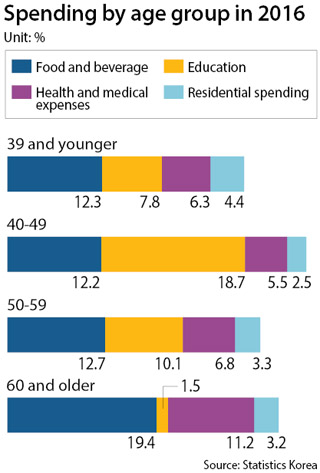50 is the new 40 when it comes to making money

Statistics Korea on Sunday announced a study conducted by the Seoul National University Asia Center and Korea Social Science Data Archive on major Korean social issues from income, spending, labor, transportation, environment and safety.
The study measures variations on income and spending based on the assumption that people under the age of 40 earn a baseline of 100. The income level of those in their 50s is the highest, at 129, followed by those in their 40s at 114.4. This is a turnaround from a decade ago when those in their 40s were the highest income earners with 111.1, followed by those in their 50s with 110.8.
But when it came to spending, those in their 40s overtook people in their 50s with 120.4 to 109.5. The reason for the higher spending was largely due to education costs. Education expenses accounted for the largest portion of spending made by those in their 40s, at 18.7 percent ,while for those in their 50s, educational expenses accounted for 10.1 percent.
But the biggest concern is rising poverty among older people. Korea has seen its population of senior citizens expand at an alarming rate.
Income and spending has been falling for those that are 60 years old and older. The income level of those above 60 years in 1996 was 90.1, which fell to 70.9 in 2006, and further dipped to 66.8.
Spending during the same period has dipped as well from 95.1 in 1996 to 73.2 in 2006 and 64.6 last year.
The study noted that spending on medical bills among those aged 60 years and older has increased significantly. The medical bills of the older generation made up about 11.2 percent of their spending, almost double that of other age brackets.
The income of older people was far less steady than other groups. In other age groups, those that made money through employment was over 70 percent.
Among those aged 60 and older, only 46.5 percent had a steady income through employment. In fact, 28.3 percent lived on non-labor-related income, including transfer payments such as pensions.
Despite the tough economic situation, the number of parents relying on their children has been shrinking. Those that rely on their children accounted for 47.4 percent as of last year, a drop from 52.9 percent in 2008. On the contrary, the amount of parents that have been trying to pay their living expenses on their own has risen from 46.6 percent to 52.6 percent.
However, the poverty situation turned out to be critical.
The poverty rate of those aged 66 or older was 49.6 percent as of 2013. That’s much higher than the OECD average of 12.6 percent.
Particularly the poverty rate of those aged 76 and older was ranked No. 1 among OECD member countries at 60.2 percent.
Child abuse has also become a major problem, with such cases nearly doubling from 66.1 cases in 2012 to 130.7 cases in 2015. Repeated offenses accounted for 45.6 percent, with physical abuse doubling from 7.7 percent of all abuses in 2011 to 16.1 percent in 2015.
Those in their 30s and 40s were the most abusive, accounting for more than 70 percent of abuse cases.
BY LEE HO-JEONG [lee.hojeong@joongang.co.kr]










with the Korea JoongAng Daily
To write comments, please log in to one of the accounts.
Standards Board Policy (0/250자)